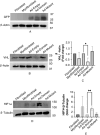SOCS domain targets ECM assembly in lung fibroblasts and experimental lung fibrosis
- PMID: 39738247
- PMCID: PMC11686354
- DOI: 10.1038/s41598-024-83187-9
SOCS domain targets ECM assembly in lung fibroblasts and experimental lung fibrosis
Abstract
Idiopathic pulmonary fibrosis (IPF) is a fatal disease defined by a progressive decline in lung function due to scarring and accumulation of extracellular matrix (ECM) proteins. The SOCS (Suppressor Of Cytokine Signaling) domain is a 40 amino acid conserved domain known to form a functional ubiquitin ligase complex targeting the Von Hippel Lindau (VHL) protein for proteasomal degradation. Here we show that the SOCS conserved domain operates as a molecular tool, to disrupt collagen and fibronectin fibrils in the ECM associated with fibrotic lung myofibroblasts. Our results demonstrate that fibroblasts differentiated using TGFβ, followed by transduction with the SOCS domain, exhibit significantly reduced levels of the contractile myofibroblast-marker, α-SMA. Furthermore, in support of its role to retard differentiation, we find that lung fibroblasts expressing the SOCS domain present with significantly reduced levels of α-SMA and fibrillar fibronectin after differentiation with TGFβ. We show that adenoviral delivery of the SOCS domain in the fibrotic phase of experimental lung fibrosis in mice, significantly reduces collagen accumulation in disease lungs. These data underscore a novel function for the SOCS domain and its potential in ameliorating pathologic matrix deposition in lung fibroblasts and experimental lung fibrosis.
Keywords: ECM; Fibroblast; Fibronectin; Myofibroblast; SOCS domain.
© 2024. The Author(s).
Conflict of interest statement
Competing interests: The authors declare no competing interests.
Figures






Update of
-
SOCS domain targets ECM assembly in lung fibroblasts and experimental lung fibrosis.bioRxiv [Preprint]. 2024 Feb 15:2024.02.14.580347. doi: 10.1101/2024.02.14.580347. bioRxiv. 2024. Update in: Sci Rep. 2024 Dec 30;14(1):31855. doi: 10.1038/s41598-024-83187-9. PMID: 38469152 Free PMC article. Updated. Preprint.
Similar articles
-
SOCS domain targets ECM assembly in lung fibroblasts and experimental lung fibrosis.bioRxiv [Preprint]. 2024 Feb 15:2024.02.14.580347. doi: 10.1101/2024.02.14.580347. bioRxiv. 2024. Update in: Sci Rep. 2024 Dec 30;14(1):31855. doi: 10.1038/s41598-024-83187-9. PMID: 38469152 Free PMC article. Updated. Preprint.
-
Human antigen R promotes lung fibroblast differentiation to myofibroblasts and increases extracellular matrix production.J Cell Physiol. 2021 Oct;236(10):6836-6851. doi: 10.1002/jcp.30380. Epub 2021 Apr 14. J Cell Physiol. 2021. PMID: 33855709 Free PMC article.
-
Overcoming interferon (IFN)-γ resistance ameliorates transforming growth factor (TGF)-β-mediated lung fibroblast-to-myofibroblast transition and bleomycin-induced pulmonary fibrosis.Biochem Pharmacol. 2021 Jan;183:114356. doi: 10.1016/j.bcp.2020.114356. Epub 2020 Dec 4. Biochem Pharmacol. 2021. PMID: 33285108
-
Cellular players in lung fibrosis.Curr Pharm Des. 2012;18(27):4093-102. doi: 10.2174/138161212802430396. Curr Pharm Des. 2012. PMID: 22630084 Review.
-
Recent advances in molecular targets and treatment of idiopathic pulmonary fibrosis: focus on TGFbeta signaling and the myofibroblast.Curr Med Chem. 2009;16(11):1400-17. doi: 10.2174/092986709787846497. Curr Med Chem. 2009. PMID: 19355895 Review.
Cited by
-
Identification of diagnostic hub genes related to energy metabolism in idiopathic pulmonary fibrosis.Front Mol Biosci. 2025 Jun 26;12:1596364. doi: 10.3389/fmolb.2025.1596364. eCollection 2025. Front Mol Biosci. 2025. PMID: 40642530 Free PMC article.
-
Exosomes are specialized vehicles to induce fibronectin assembly.bioRxiv [Preprint]. 2025 Jun 24:2025.06.23.661091. doi: 10.1101/2025.06.23.661091. bioRxiv. 2025. PMID: 40667058 Free PMC article. Preprint.
References
-
- Monaghan, H. et al. Prognostic implications of histologic patterns in multiple surgical lung biopsies from patients with idiopathic interstitial pneumonias. Chest125, 522–526 (2004). - PubMed
-
- Perez, A., Rogers, R. M. & Dauber, J. H. The prognosis of idiopathic pulmonary fibrosis. Am. J. Respir. Cell Mol. Biol.29, S19-26 (2003). - PubMed
-
- Raghu, G., Weycker, D., Edelsberg, J., Bradford, W. Z. & Oster, G. Incidence and prevalence of idiopathic pulmonary fibrosis. Am. J. Respir. Crit. Care Med.174, 810–816. 10.1164/rccm.200602-163OC (2006). - PubMed
MeSH terms
Substances
Grants and funding
LinkOut - more resources
Full Text Sources

